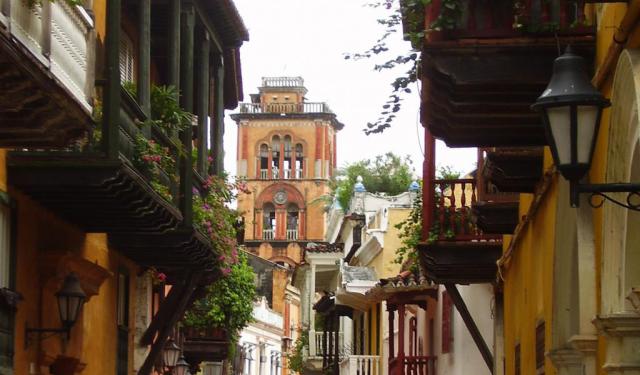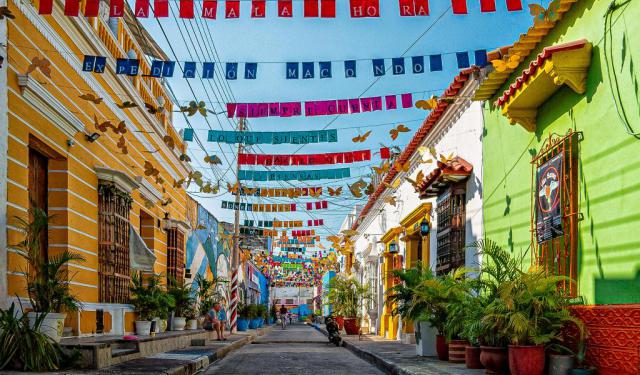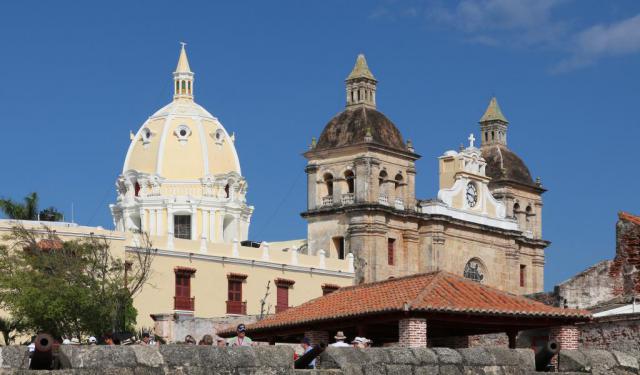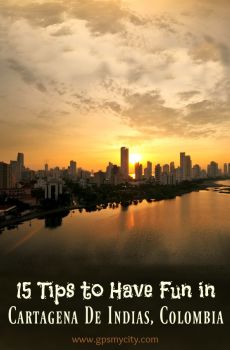
Calle de la Sierpe (Serpent Street), Cartagena
The first thing you notice on Calle de la Sierpe (Serpent Street) is the bright colors on the walls and the flags hanging over your head as you walk. Looping around from Calle Media Luna to the emblematic Plaza de la Trinidad (a place where important historical events once took place, determining the independence of Cartagena and consequently that of Colombia), this street – also known as Calle 29 – has a great deal of historical importance attached to it. However, it is the abundance of urban art illustrating the legends and mysteries surrounding Calle de la Sierpe's past that makes it one of the most popular destinations in the city.
Indeed, the ubiquitous graffiti here is the main attraction; found practically everywhere – on the walls, doors, and windows, and sometimes even on ruined buildings, – they effectively turn the area into one big photo op.
Standing out among them, in particular, are the two artworks: the Grinning Afro-Colombian Woman, and La Sierpe. The former – a large, striking mural by Dexs – is one of the most photographed pieces of street art in Cartagena. As for the latter (La Sierpe), this depiction of a half-woman, half-snake refers to a legend that gave the street its name.
Back in 1608, locals were often bothered by a hissing sound at night that came from what seemed like a big creature crawling on the ground, making a rattling noise. Gripped by fear, the people complained to the city mayor, Don Antonio de Viloria, who bravely ventured out several nights to find out the cause of it. One night, he finally managed to unveil the mystery – a giant rattlesnake! The serpent appeared out of nowhere, with its menacing phosphorescent eyes, wriggling and noisily shaking the large rattles on its tail.
The mayor, armed with courage and the magic technique he had learned on the island of Santa Domingo, drew some magical figures in the air, immediately after which the snake started to writhe and transformed into a woman, who happened to be a witch. The sorceress begged for forgiveness and implored clemency. According to the legend, she was imprisoned until 1614 when the Holy Inquisition Court sentenced her to 200 lashes and final banishment – for heresy.
As you venture further down the street, keep your eyes peeled for the depictions of indigenous people, as well as some other images, to get a sense of the fascinating ethnic diversity of the local population.
Indeed, the ubiquitous graffiti here is the main attraction; found practically everywhere – on the walls, doors, and windows, and sometimes even on ruined buildings, – they effectively turn the area into one big photo op.
Standing out among them, in particular, are the two artworks: the Grinning Afro-Colombian Woman, and La Sierpe. The former – a large, striking mural by Dexs – is one of the most photographed pieces of street art in Cartagena. As for the latter (La Sierpe), this depiction of a half-woman, half-snake refers to a legend that gave the street its name.
Back in 1608, locals were often bothered by a hissing sound at night that came from what seemed like a big creature crawling on the ground, making a rattling noise. Gripped by fear, the people complained to the city mayor, Don Antonio de Viloria, who bravely ventured out several nights to find out the cause of it. One night, he finally managed to unveil the mystery – a giant rattlesnake! The serpent appeared out of nowhere, with its menacing phosphorescent eyes, wriggling and noisily shaking the large rattles on its tail.
The mayor, armed with courage and the magic technique he had learned on the island of Santa Domingo, drew some magical figures in the air, immediately after which the snake started to writhe and transformed into a woman, who happened to be a witch. The sorceress begged for forgiveness and implored clemency. According to the legend, she was imprisoned until 1614 when the Holy Inquisition Court sentenced her to 200 lashes and final banishment – for heresy.
As you venture further down the street, keep your eyes peeled for the depictions of indigenous people, as well as some other images, to get a sense of the fascinating ethnic diversity of the local population.
Want to visit this sight? Check out these Self-Guided Walking Tours in Cartagena. Alternatively, you can download the mobile app "GPSmyCity: Walks in 1K+ Cities" from Apple App Store or Google Play Store. The app turns your mobile device to a personal tour guide and it works offline, so no data plan is needed when traveling abroad.
Calle de la Sierpe (Serpent Street) on Map
Sight Name: Calle de la Sierpe (Serpent Street)
Sight Location: Cartagena, Colombia (See walking tours in Cartagena)
Sight Type: Attraction/Landmark
Guide(s) Containing This Sight:
Sight Location: Cartagena, Colombia (See walking tours in Cartagena)
Sight Type: Attraction/Landmark
Guide(s) Containing This Sight:
Walking Tours in Cartagena, Colombia
Create Your Own Walk in Cartagena
Creating your own self-guided walk in Cartagena is easy and fun. Choose the city attractions that you want to see and a walk route map will be created just for you. You can even set your hotel as the start point of the walk.
Cartagena Introduction Walking Tour
Cartagena is a charming port city situated on the Caribbean coast of Colombia, South America. It was founded in 1533 by Pedro de Heredia, a Spanish conquistador. The city is known in Spanish as "Cartagena of Indies" and is named after the city of Cartagena in Spain.
In the pre-Columbian era, indigenous people became settled in the region. The Puerto Hormiga culture dates back as early... view more
Tour Duration: 2 Hour(s)
Travel Distance: 2.4 Km or 1.5 Miles
In the pre-Columbian era, indigenous people became settled in the region. The Puerto Hormiga culture dates back as early... view more
Tour Duration: 2 Hour(s)
Travel Distance: 2.4 Km or 1.5 Miles
Getsemani Public Arts Walking Tour
Long known as the "neighborhood of the poor" ill-reputed for criminal activity, the district of Getsemani has recently undergone massive gentrification to become Cartagena's hippest area and one of Latin America's newest hotspots. The local plazas, once occupied by drug dealers, have been reclaimed, and the derelict buildings turned into boutique hotels.
But most... view more
Tour Duration: 1 Hour(s)
Travel Distance: 0.8 Km or 0.5 Miles
But most... view more
Tour Duration: 1 Hour(s)
Travel Distance: 0.8 Km or 0.5 Miles
Colonial Architecture Walk
Visiting Cartagena can be a remarkable experience, especially for those keen on architecture. The beautifully-preserved, mostly colonial-style, buildings in the historic center have long been one of the main attributes of this once burgeoning Colombian town.
Recognizing colonial Cartagena is easy, as it is surrounded by colossal stone walls tracing the outline of the old city. The downtown... view more
Tour Duration: 1 Hour(s)
Travel Distance: 2.0 Km or 1.2 Miles
Recognizing colonial Cartagena is easy, as it is surrounded by colossal stone walls tracing the outline of the old city. The downtown... view more
Tour Duration: 1 Hour(s)
Travel Distance: 2.0 Km or 1.2 Miles
Useful Travel Guides for Planning Your Trip
15 Tips to Have Fun in Cartagena De Indias, Colombia
Because of its troubled past, you will hear many nicknames to describe Cartagena de Indias. The magic city, The Heroic, The Rock Corral, The jewel of the Caribbean Coast. The mere mention of them allows you to travel through the history, from pirates and slavery to the revolutions for their...




